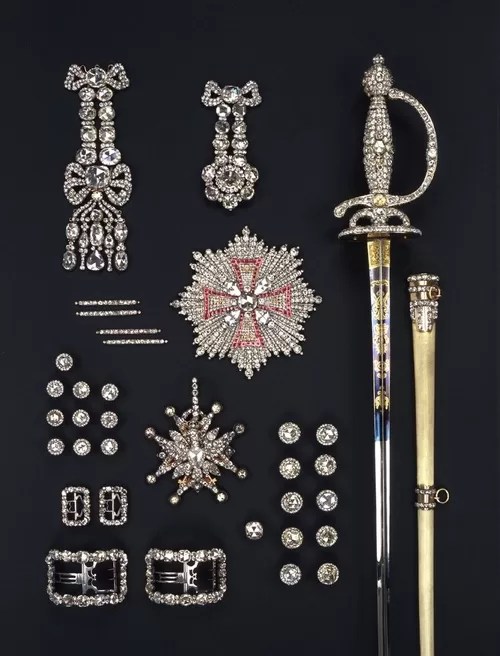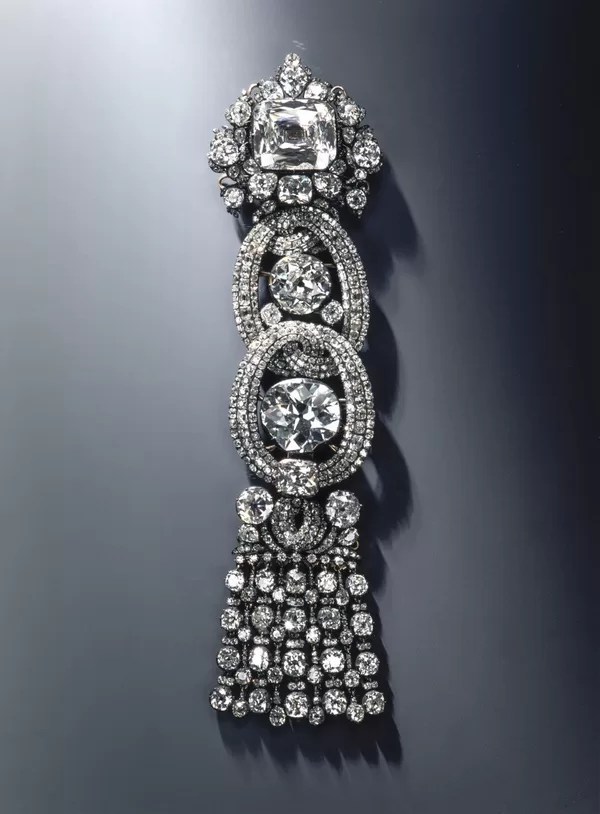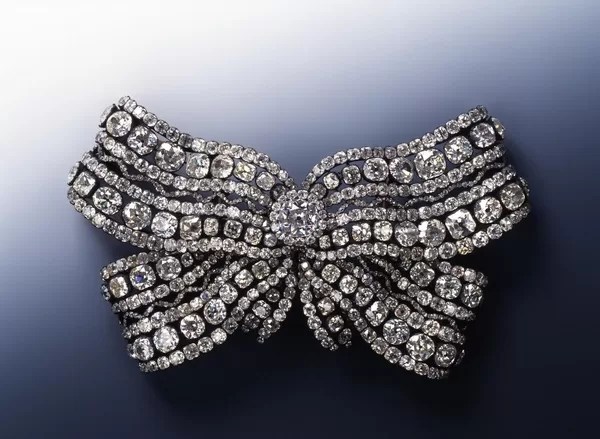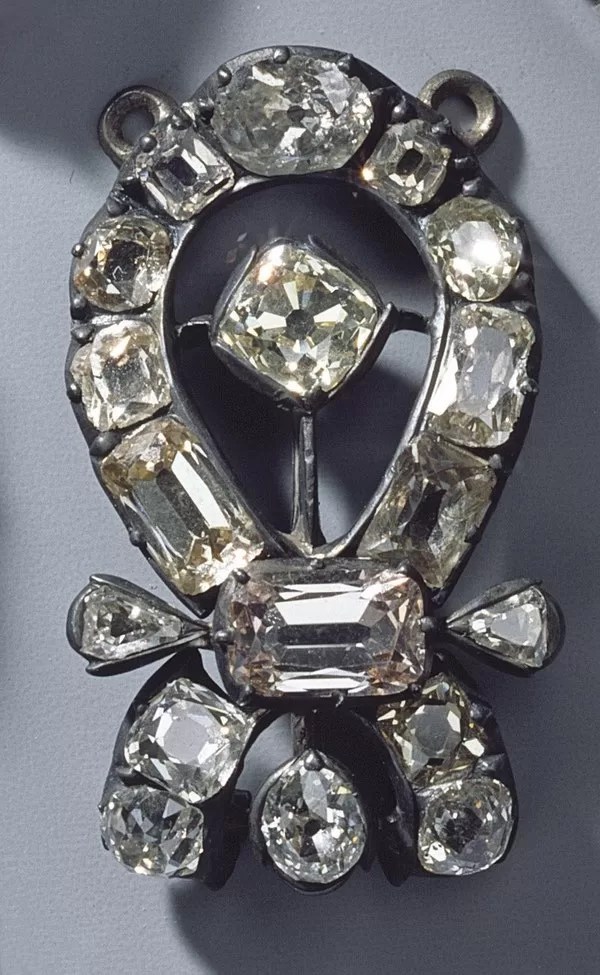Five burglars who stole €113.8 million in jewels, including the Queen’s Jewellery from the Jewel Room, Historic Green Vault at the Royal Palace Dresden were found guilty of the crime.
The men, aged 24 to 29 and all members of the same family, were given prison sentences of between four years and four months and six years and three months. One defendant was acquitted.
The thieves broke into the Historisches Grüne Gewölbe (Historic Green Vault) on 25 November 2019 and stole €113.8 million in jewels, pictured below. It is the largest museum heist in history, surpassing the value of the Isabella Stewart Gardner Museum theft of 1990.
The jewels have not been recovered. The whereabouts of the jewels with over 4,300 diamonds is still unknown. Police are offering €500,000 reward for anyone who could give information leading to the jewels.
The defendants, aged between 22 and 28, are all from the same family known as the Remmo clan, with two of them already sentenced to four and a half years in prison for stealing the ‘Big Maple Leaf’, a 100-kg (220-pound) gold coin worth €3.75 million from Berlin’s Bode Museum in 2017.
The stolen Dresden collection was assembled in the 18th century by Augustus the Strong, Elector of Saxony and later King of Poland, who commissioned ever more brilliant jewellery as part of his rivalry with France’s King Louis XIV.
The treasure survived Allied bombing in World War Two and was taken back to the Soviet Union as war booty. The jewels were returned to Dresden, the historic capital of the state of Saxony, in 1958.
DNA of men found in car with glass fragments from the museum display case
Investigators found glass shards from the jewellery’s display cabinet in a getaway car, which had been set alight. The cabinet had been smashed with an axe during the theft.
Police found DNA traces from three of the accused men in the vehicle.
The gang are accused of aggravated gang theft, arson, and aggravated arson. A fire lit in an electricity junction box in the old part of the city and the torched a getaway car in a basement parking garage caused €1 million in property damages.
Another man has been charged with aiding and abetting a criminal act after police found confidential copies of the investigation and prosecutors’ case files in his apartment although it is unclear how he obtained them. He was arrested in the courthouse while he was watching the proceedings.
The Remmo clan has, among other things, been investing in Berlin real estate. Authorities there confiscated 77 houses and apartments owned by the family in 2018. All the men are born in Germany from Lebanese immigrants.
They have been accused of stealing millions in cash from banks as well as items from museums that have never been seen again.
Authorities fear the unique works stolen in Dresden may never be seen again and may be destroyed to sell the individual gemstones.
What was stolen from the Green Vault in Dresden?
The display case in the Jewel Room which was targeted by the thieves contained the sets of rose-cut and brilliant-cut diamonds, along with the queens’ diamond jewellery and pearls (roughly 100 individual items).
The three sets contain diamonds in various cuts, the majority of which were acquired by Augustus the Strong and Augustus III. Most were set in their mountings between 1782 and 1789.
The missing pieces are shown below, grouped into the three sets.
Garnitures at the Green Vault stolen during the burglary
Stolen Diamond Rose Garniture
“große Rauten Garnitur” (jewel inventory of 1719) consisting of: 10 Skirt and 10 Waistcoat Buttons (1753), Breast star of the Polish Order of the White Eagle (1753), Badge (Kleinod) of the Polish Order of the White Eagle (1782-1789), two curved Shoe Buckles (1782-1789), two Knee Buckles (1782-1789), Hat Brim Ornament (1782-1789), four Braids belonging to the Hat Brim Ornament (1782-1789), large rose cut Diamond, Epaulette (1782-1789), Rapier with Sheath (1782-1789)

Stolen objects: Rapier (1782-1789), two curved Shoe Buckles (1782-1789), Hat Brim Ornament (1782-1789), Badge (Kleinod) of the Polish Order of the White Eagle (1782-1789), large rose cut Diamond, Epaulette (1782-1789) (fragment remaining), 10 Skirt Buttons (1753) (some remaining)
Stolen Diamond Rose Garniture


The Dresden White Diamond (also known as Dresden White or the Saxon White) is a 62-carat (12.4 g) cushion-cut diamond that probably originated from the Golconda mines in Southern India.
One of the Green Vault’s best known treasures – the 41-carat Dresden “Green Diamond” – was away on loan at New York’s Metropolitan Museum of Art at the time of the break-in.


Epaulette (1782-1789)

Stolen Diamond Garniture
The most precious jewellery garniture at the Grünes Gewölbe consisting of: a pair of double Cufflinks (1743, last re-set 1764), Breast star of the Polish Order of the White Eagle (between 1746 and 1749), Piece of Jewellery in the shape of a Palmette (1746), Hat Ornament with the Dresdner Grüne Diamond (1769), six bow-shaped Braids belonging to the Hat Ornament with the Dresdner Grüne (1769 und 1824), Hat Jewellery (so-called Reiherstutz, between 1782 and 1807), four straight Braids belonging to the Hat Jewellery (1782 and 1807), yellow Diamond without setting, Epaulette with the Sächsische Weiße Diamond in brilliant cut (1782 und 1789), Rapier with Sheath (1782 und 1789), two Shoe Buckles (1782 und 1789), two Knee Buckles (1782 und 1789), 10 Skirt and 10 Waistcoat Buttons (1827)

Stolen objects: Hat Jewellery, so-called Reiherstutz (between 1782 and 1807), Epaulette with the Saxon White Diamond in brilliant cut (between 1782 and 1789), Breast star of the Polish Order of the White Eagle (between 1746 and 1749)

Epaulette with the Saxon White Diamond in brilliant cut (between 1782 and 1789)
Stolen Queens’ Jewellery
The Queen’s jewellery consisting of: Hair Pin with a long Diamond Drop carried by an Eagle (1713, modified after 1719), Fragment of a Muff Hook (1746 and 1749), large Bow-shaped Brooche of the Queen Amalie Auguste (1782), Jewellery Pin on a Flower Branch (1782), Jewellery Pin on a an triple Bow (1782-1789), three Aigrettes for the Hair in the Shape of a Sun, half a Sun and a Crescent Moon (between 1782 and 1807), two Ear Pendants belonging to the Diamond Collar (1819), ten Hair Pins (1820), Diamond Collar of Queen Amalie Auguste (1824), Necklace with 177 Saxon Pearls (before 1734), Necklace with 228 Oriental Pearls (since 1824 part of the Crown Jewels)

Stolen objects: Large Bow-shaped Brooch of the Queen Amalie Auguste (1782), Aigrette for the Hair in the shape of a Sun (between 1782 and 1807), Fragment of a Muff hook (1746 and 1749), Diamond Collier of the Queen Amalie Auguste (1824) (Fragments remaining)

Large Bow-shaped Brooch of the Queen Amalie Auguste (1782)


The jewels have not been recovered.
Related stories
Colonel Blood’s plot to pinch the British Crown Jewels
INTERPOL’s global database of Stolen Works of Art
World’s most exquisite pink diamonds at Melbourne Museum
How to Clean Pearls ° Cultured Pearl Types Explained
FBI Top Ten Art Crimes, FBI Art Crimes Team – Updated
FBI Foils Geronimo’s Headdress Sale




